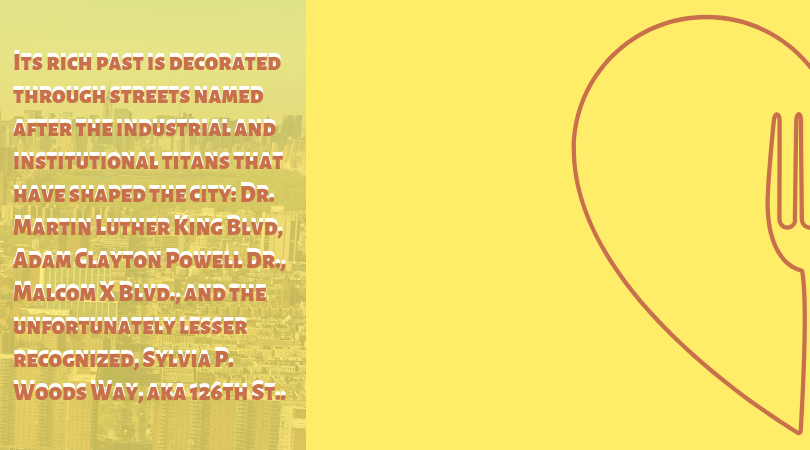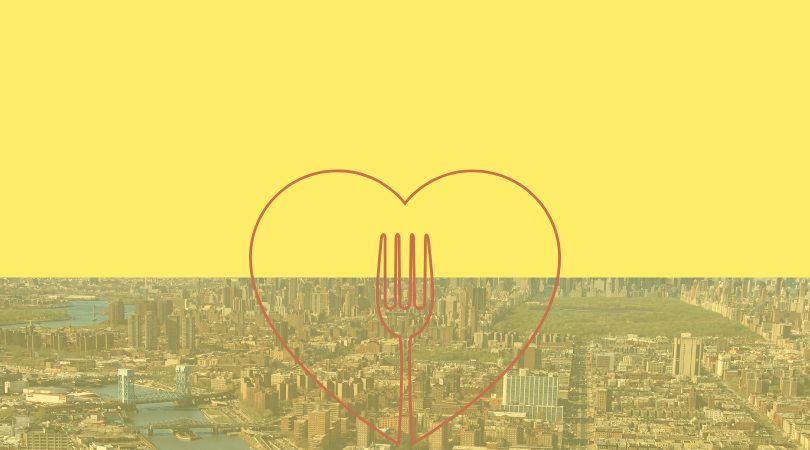Harlem and Food: Yesterday, Today, and Tomorrow
Words by Matthew Romano
Illustration by Katie Herchenroeder
Take a second and think about the neighborhoods in NYC withthe best culture and food scene. What comes to mind? Were you taken back to thesmells from the international food carts of Tribeca wafting higher than theskyscrapers? What about the sweet smoke of thin sliced bulgogi searing on theKorean BBQ plates in K-Town? Chances are if Harlem passed through your sensememory, it was for the homey comfort of soul food.
While soul food is central to the identity of the Harlemcommunity and its history, in 2019, it is clear that it is only part of thestory, one that spans over a century of an ever-changing landscape of people,places, and of course, tastes.
Key to understanding the food scene in Harlem isunderstanding its history - as the two are indivisible. Undoubtedly, Harlem isconsidered one of, if not the, soul food capitol of the world; but where didthis food come from? Soul food, put succinctly, finds its roots in centuries ofslavery. Thanks to 20th century spikes in immigration and the GreatMigration, it’s found its place and power in today’s world. Specific to Harlem,these events, intertwined with the Harlem Renaissance of the 1920’s followed bythe Civil Rights Movement of the 1960’s, have allowed this cuisine to rise outof its beginnings and make a name for itself and its neighborhood while respectingand honoring its history and serving as a culinary anthem for its large AfricanAmerican population.

Central to any discussion of soul food in Harlem is restauranteurSylvia Woods, dubbed the Queen of Soul food. Her world-famous Sylvia’s, locatedat 328 Lenox Avenue, was a major factor in Harlem’s soul food scene’s meteoricrise to stardom, renown, and reputability. Such a feat is an even more importantstep when looked at through a lens of the cultural history of the struggle forequality at the time of its founding, 1962.
There are, however, some other lesser-known historical, demographicalevents that make up Harlem’s food history that should not be discounted.
Following World War II, the name Spanish Harlem or “ElBarrio” became synonymous with East Harlem for the district’s new arrivals fromLatin America. Outside of this enclave, west African and west Indianpopulations also made a presence in the 1940s to 1950s, just as the AfricanAmerican population had reached its peak in the neighborhood. For reference, 98%of the population was African American in 1950. Demographically, Harlem hasmore recently gone under dramatic shifts. 2017 Census data for Harlem show thatAfrican Americans only maintain a majority in the albeit significantly larger district10, Central Harlem at 53%, while the Hispanic population has increased in Eastand West Harlem. Diversity is palpable for City College students as they are membersand friends of the 150 different countries and 90 different languages that makeup the college’s voice and identity. A food stroll through the streets of theHarlem neighborhood brings this into reality

Now, picture this: you have a 3-hour break between yourclasses; it is a brisk afternoon; and you have not eaten since the night before- because what college student really has time for breakfast?. You start from theNAC’s back entrance at 137th street and try to scope out your lunchoptions. You want something affordable, cannot be too picky and do not reallyhave a specific craving to limit your options as you wander. You walk on andrestaurants begin shouting out their specific cuisines to you as you pass themphysically and as they linger in your mind.
Italian (Fumo), Chinese take-out (Grand Great Wall), Comfort/SoulFood (Home Sweet Harlem), Japanese (Rai Rai Ken, Sushi Sushi), Mexican (Oso),Indian (Clove), even Greek (newly opened, Whaddapita) and, because it needs no introduction,Empanadas Monumental.
Any which way you meander down this avenue and along thisstroll, you are sure to find yourself somewhere the food is as diverse as thecollege where you study - while also being easy on the pocket and even easieron the taste buds.
One last time, picture this: you are riding the m100 bus, lookingout the window to scope out your next culinary escapades. 125th St.,certainly one of the primary streets in Harlem’s political (Adam Clayton PowellState Office Building), cultural (Apollo Theater), and culinary (Sylvia’s)histories, also paints an interesting picture of the Harlem of yesterday,today, and tomorrow.
Its rich past is decorated through streets named after theindustrial and institutional titans that have shaped the city: Dr. MartinLuther King Blvd, Adam Clayton Powell Dr., Malcom X Blvd., and theunfortunately lesser recognized, Sylvia P. Woods Way, aka 126th St..

In the present, you hear the noise emanating from the AMC Magic Johnson Harlem 9, the people crowding chain stores ushered in through gentrification, and the stands of handcrafted essential oils, natural remedies, and, of course, Harlem swag. The future stands out and looks flashy but perhaps, slightly problematic. For example, the Whole Foods you spot as you ride the crosstown bus cannot be ignored with all the backlash it has received. Further along, Shake Shack, Chipotle, Taco Bell, new luxury-like apartments, and high-rises scream gentrification and look tempting surely, but out of place when juxtaposed with store closing signs on thrift stores and cheaper retail options you remember frequenting.
At once, brownstones where you grew up are whittling down and the reminiscent scents like Amy Ruth’s Chicken and Waffles and Sylvia’s Peach Cobbler fly through the air. Regardless of whether you treat Harlem’s tomorrow with praise or vitriol, or whether Harlem’s institutions of the past still hold dominion over your perception or are slowly retreating from view, their presence cannot be denied. Through a look at the city-like neighborhood of Harlem today, a vision of a beautifully complicated, post renaissance, and perhaps pre-revolution backdrop of sights, smells, tastes, and faces becomes more and more clear.
Through this picturing you see a food scene with an authentic, humble beginning in mom and pop shops, accompanied by a grand and simultaneously clashing rise of big chains. So, CCNY food adventurer, as you step out of the NAC, where will your tastes lead you?





